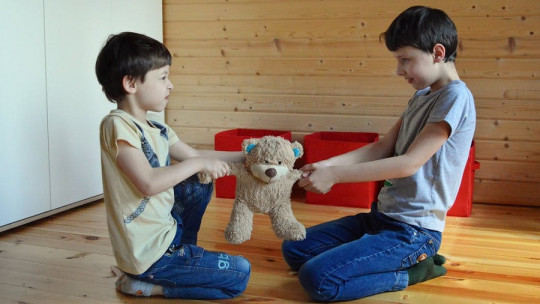
Fights between siblings in childhood or adolescence are normal as long as they are controlled and do not affect the psychological state of any of them.
Different variables and factors have been observed that intervene in the appearance of rivalry between siblings; feelings of jealousy and envy are those that most likely lead to this dynamic of competition. To try to ensure that these behaviors do not negatively influence children, parents can use different strategies, such as reinforcing appropriate behaviors or dedicating the relevant time to each child or turning to psychologists.
In this article you will know better what causes and factors lead to rivalry between siblings and what strategies you can apply as a father or mother to try to improve the relationship between them.
What do we understand by sibling rivalry?
Sibling rivalry, also called fraternal rivalry, is the set of painful and negative emotions, feelings, cognitions and behaviors that children can experience with their siblings when understanding the relationship as an area in which to compete
In the relationship between siblings it is easy and normal for there to be fights, quarrels, shouts… But we must control the duration and magnitude of these, since if the situation worsens, this can impact the mental health of children or adolescents The age at which the greatest rivalry occurs ranges from 10 to 15 years, with a tendency to decrease with age, although on some occasions it has been seen that it can persist into adulthood.
In this way, it is necessary that we be attentive and act when necessary; and if necessary, seek psychotherapeutic support.
Causes that generate the appearance of rivalry
As we have seen, it is to a certain extent normal for quarrels to appear between siblings, since they share a lot of time together, grow up in the same space, with the same toys and receive the love of the same people, so it is common for them to sometimes fight. express negative feelings or thoughts regarding the other or negative behaviors directed at them.
The negative feelings that have been observed most in sibling relationships are envy and jealousy ; In moderate amounts these are normal and we should not worry, but if these feelings become pathological or increase in intensity they can have an impact on the child’s condition.
Envy is defined as a feeling that appears before the desire to possess what the other person has It is common for this experience to be more complex and one does not only want to possess what the other person has, but also for the other person to lose what they have; In other words, we get what is his and he stops having it.
Regarding jealousy, these are understood as a feeling that a subject experiences when faced with the belief that another person loves a third party more than oneself Thus, it is not pathological for jealousy to appear between siblings, since they are sharing the love or affection of their parents; The problem is when these feelings affect them and impact their psychological state.
In the family system, different relationships or links may appear that give rise to what is known as a triangle These, in turn, are divided into two types: alliances (where proximity occurs between two family members in contrast to a third; in this case the relationship is open and clear, without trying to harm the other) and coalitions (these are defined as the proximity that exists between two of the members of the triad as opposed to a third; this link will be hidden and denied, and in this case the triad will receive the specification of perverse).
So we see how In jealousy, the figure of the parents does intervene more, since it is the main subject that causes this emotion. On the other hand, envy links only the two brothers, and the causes may be different, such as having or not having an object or each having different abilities and skills.

Variables that affect the sibling relationship
Obviously, although we share similar characteristics with our brothers, each of us has our personality, our identity that differentiates us from others. Despite being raised in the same environment and by the same parents, differences also occur caused by different variables.
Family environmental variance can be divided into two classes: common, interfamilial or shared variance (refers to common factors shared by all individuals in the same family) or specific, non-shared or intrafamilial variance (it is due to specific factors that affect each subject in the same nucleus in a different way familiar).
Let’s see what these different factors can be inside and outside the family environment that affect the development of the subject and can lead to rivalry or problems between siblings.
1. The age difference between siblings
It has been observed that the smaller the age difference, the greater the tendency to fight The reasons may be different; For example, in the case of being older, the older brother develops a protective attitude towards his brother; or by getting along less with this one, the other may be more likely to be perceived as a rival, as someone with whom one must compete or who may pose a threat.
2. Same sex
Similar to age, if the sex is the same, we are more likely to see the other as an equal, someone with whom we must compete to achieve our desires based on gender roles
3. Being the middle child
Birth order is also a variable within the family environment that affects each child differently. In this way, it has been seen that older siblings are normally the ones who receive more attention and greater control, since they are the first-born and enjoyed a time in which they do not have to “share” their parents with anyone else; and young children are normally the most protected, both by their parents and their siblings.
Contrary, Middle children may receive less attention and as a result try to act flashy to get their parents’ attention.
4. Parental divorce
Divorce or separation of parents is also an influencing factor, since Parents’ treatment of their children may vary or be different Furthermore, this experience usually involves a new and unpleasant situation for the child, who can experience this stage with stress and anxiety, which can lead to bad behavior.
How to reduce sibling rivalry
Keeping in mind that as a general rule all parents want the best for their children, it may be that in circumstances their behavior, without being malicious, is not the most appropriate.
Likewise, there are different strategies that parents can use to reduce and control the rivalry that is created between their children or at least not contribute to its increase.
1. Don’t compare
As we have seen, the behavior of each child will vary even if the education received is the same. It is very important that when faced with behaviors that one of the children performs better, we do not compare them, since this fact increases the possibility of increasing rivalry. If one of our children does not do a behavior well, we will try to make them see that there are other more appropriate ways of behavior or we will help them improve, but never by comparing them with another.
2. Treat each child in a personalized way
Try, as far as possible, to treat each of your children according to their characteristics, tastes, preferences… Sometimes the best procedure is not to always give the same thing but to adapt it to your needs and desires
Look at what each person claims, since more individualized treatment creates more distinction between one and the other and can help perceive the other in a less competitive way, that is, develop less rivalry.
3. Not positioning yourself
When your children fight, try to help and encourage them to talk and fix things, but don’t agree with any of them because this will only make the situation worse and the rivalry between them will grow.
4. Dedicate time to each child
Each child has their needs, each expressing them in different ways, but they all deserve and need the same attention, so You must distribute the time equally between everyone that they feel listened to and that they are cared for.
One of your children may have more difficulties or more needs, but this fact does not mean that the others should also feel cared for, they are still children who require their parents to be there for them.
5. Reward positive behaviors
In order for your child to learn appropriate behaviors and know how he or she should behave, a good way of acting is reward, reinforce, appropriate behaviors and extinguish the negative ones. This process consists of ignoring the behavior that we want to reduce if it does not go against the rules (it is normal for it to increase at first, but later we will see how it begins to decrease and disappear).
- Related article: “BF Skinner’s theory of reinforcement”
6. Avoid fights
Nobody knows your children better than you. You know what behaviors make them angry or what their preferences are Sometimes it will be better to prevent and thus avoid the fight from happening. For example, a strategy that can work is to give each person a toy so that they do not fight and an argument arises over wanting the same one.








